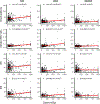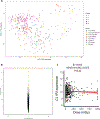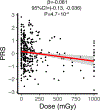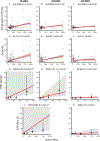Radiation-related genomic profile of papillary thyroid carcinoma after the Chernobyl accident
- PMID: 33888599
- PMCID: PMC9022889
- DOI: 10.1126/science.abg2538
Radiation-related genomic profile of papillary thyroid carcinoma after the Chernobyl accident
Abstract
The 1986 Chernobyl nuclear power plant accident increased papillary thyroid carcinoma (PTC) incidence in surrounding regions, particularly for radioactive iodine (131I)-exposed children. We analyzed genomic, transcriptomic, and epigenomic characteristics of 440 PTCs from Ukraine (from 359 individuals with estimated childhood 131I exposure and 81 unexposed children born after 1986). PTCs displayed radiation dose-dependent enrichment of fusion drivers, nearly all in the mitogen-activated protein kinase pathway, and increases in small deletions and simple/balanced structural variants that were clonal and bore hallmarks of nonhomologous end-joining repair. Radiation-related genomic alterations were more pronounced for individuals who were younger at exposure. Transcriptomic and epigenomic features were strongly associated with driver events but not radiation dose. Our results point to DNA double-strand breaks as early carcinogenic events that subsequently enable PTC growth after environmental radiation exposure.
Copyright © 2021 The Authors, some rights reserved; exclusive licensee American Association for the Advancement of Science. No claim to original U.S. Government Works.
Conflict of interest statement
Competing interests:
E.T.D. is an employee of Nvidia Corporation and owns stock in Nvidia, Illumina, and Pacific Biosciences. G.G. receives research funds from IBM and Pharmacyclics, and is an inventor on patent applications related to MuTect, ABSOLUTE, MutSig, MSMuTect, MSMutSig, MSIdetect, POLYSOLVER and TensorQTL. G.G. is a founder, consultant and holds privately held equity in Scorpion Therapeutics. All other authors declare no competing interests.
Figures







References
-
- United Nations Scientific Committee on the Effects of Atomic Radiation (UNSCEAR), “Sources and Effects of Ionizing Radiation: UNSCEAR 2008 Report to the General Assembly, with Scientific Annexes,” (United Nations Publication, New York, 2010).
-
- Tronko M et al., Thyroid neoplasia risk is increased nearly 30 years after the Chernobyl accident. Int J Cancer 141, 1585–1588 (2017). - PubMed
-
- International Agency for Research on Cancer (Lyon, France, 2012).
Publication types
MeSH terms
Substances
Grants and funding
LinkOut - more resources
Full Text Sources
Other Literature Sources
Medical
Research Materials

